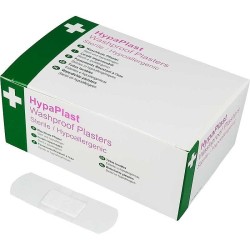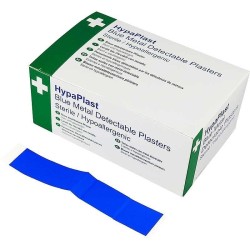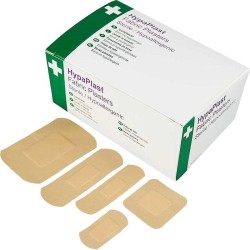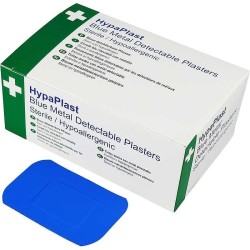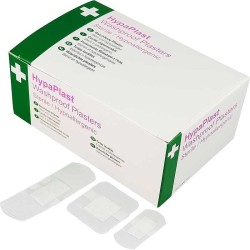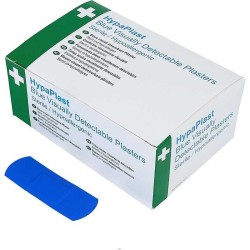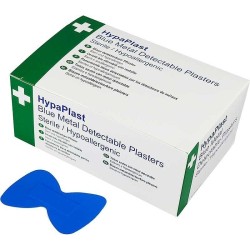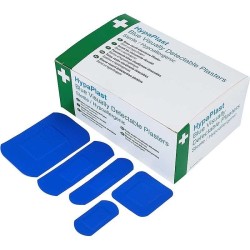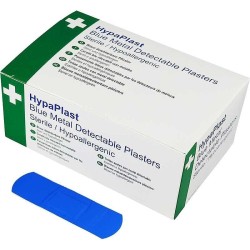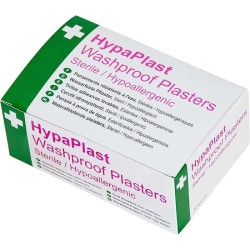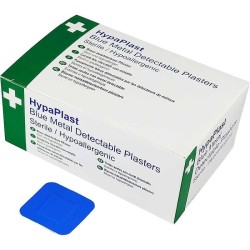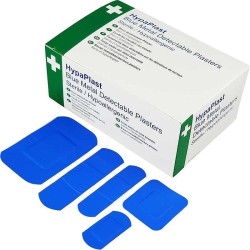First Aid Plasters
Subcategories
First Aid Blister...
Specialised Protection for Friction Blister Management
First aid blister plasters provide specialist cushioned protection specifically designed for friction blisters across workplaces, sports environments, outdoor activities, and occupational health contexts throughout England, Scotland, Wales, and Northern Ireland. These purpose-designed products comprise hydrocolloid or gel cushioning materials providing immediate pain relief whilst promoting healing, addressing blisters caused by footwear friction, equipment use, or repetitive movement. Organisations rely on blister plasters for immediate blister treatment and pain relief, friction reduction preventing blister worsening, healing support through optimal moisture environment, continued activity enablement, and specialist wound care. Modern blister plasters incorporate features including hydrocolloid technology maintaining optimal wound moisture, cushioning reducing pressure and friction, secure adhesion through tapered edges, varied shapes addressing different blister locations particularly heels and toes, and transparent materials enabling monitoring. The provision of blister plasters demonstrates commitment to occupational health, supports continued activity despite blisters, enables professional wound care, and fulfils specific injury management requirements across active environments throughout professional contexts.
The implementation of blister plasters directly supports continued activity capability, pain relief, and demonstration of professional wound care. Blisters represent common injuries in active occupations and sports potentially limiting capability unless appropriately managed. Blister plasters address these needs by providing immediate pain relief through cushioning, reducing friction preventing blister progression, supporting healing through hydrocolloid moisture management, enabling continued activity when treatment prevents deterioration, and demonstrating professional occupational health care. Application scenarios include workplace blisters from new footwear or equipment, sports blisters during training or competition, outdoor activity blister management, occupational blisters from repetitive tasks, and preventative application protecting vulnerable areas. Organisations benefit from blister plasters through maintained productivity when treatment enables continued work, enhanced athletic performance through pain management, demonstrated professional care, and specialist capability addressing common injuries. Modern blister plasters incorporate features such as advanced hydrocolloid formulations, contoured shapes, and extended wear capability throughout England, Scotland, Wales, and Northern Ireland.
Selecting and implementing blister plasters requires assessment of blister risks, appropriate product specification, and integration with occupational health or sports medicine protocols across organisations throughout the UK. Occupational health professionals and sports managers should evaluate typical blister scenarios determining product requirements, assess locations requiring varied plaster shapes, consider preventative use in high-risk activities, and calculate adequate stock levels. Product selection should prioritise hydrocolloid or advanced gel formulations providing optimal healing, varied shapes addressing different locations particularly heel and toe designs, appropriate sizes, secure adhesion enabling extended wear, and adequate quantities ensuring availability. Implementation protocols should encompass integration with occupational health or sports medicine supplies, education on blister plaster application including clean dry skin preparation and proper positioning, preventative use strategies, and documented supply management. Quality assurance measures should include regular stock checks, usage monitoring identifying high-risk activities or locations, evaluation of effectiveness, and incident integration. Modern blister plaster management may incorporate preventative programmes. Organisations should establish blister management protocols including appropriate plaster use, integrate with occupational health or athletic care systems, and maintain documentation. Active industries and sports organisations require readily accessible blister plaster stocks. Staff and athlete education should address blister plaster purposes, preventative application before blisters develop, correct application technique, extended wear capability, and recognition when medical assessment is required for infected blisters. Storage should protect adhesive properties whilst ensuring accessibility. By implementing blister plasters alongside professional protocols, organisations throughout England, Scotland, Wales, and Northern Ireland demonstrate commitment to occupational health and athletic welfare, continued activity enablement, professional wound care, and specialist capability supporting optimal outcomes through effective pain relief and healing promotion across all active working and sports environments with blister risks.
First Aid Blue Metal...
Detectable Wound Protection for Food Industry Compliance
First aid blue metal detectable plasters provide specialist wound protection incorporating metal strips enabling detection by metal detectors, serving food manufacturing, catering, and food handling environments throughout England, Scotland, Wales, and Northern Ireland. These essential food industry products combine highly visible blue colouring with embedded metal strips, ensuring lost plasters can be detected before products reach consumers, supporting HACCP compliance and food safety. Food industry organisations rely on blue metal detectable plasters for food handler wound protection meeting regulatory requirements, foreign object prevention through detectability, visual identification through distinctive blue colouring, HACCP compliance demonstration, and comprehensive food safety management. Modern blue metal detectable plasters incorporate features including embedded metal strips detectable by standard metal detectors, bright blue colouring easily visible against food products, strong adhesion maintaining position during food handling, waterproof properties withstanding hand washing, and varied sizes accommodating different wounds. The provision of blue metal detectable plasters demonstrates commitment to food safety, supports regulatory compliance, enables professional food industry wound management, and fulfils essential HACCP requirements across food production and handling environments throughout professional food industry contexts.
The implementation of blue metal detectable plasters directly supports food safety, regulatory compliance, and demonstration of professional food industry hygiene management. Food industry regulations require measures preventing foreign object contamination, with appropriate wound covering and detectability essential. Blue metal detectable plasters address these requirements by enabling metal detector identification if plasters are lost, providing visual detectability through distinctive blue colouring absent from food products, supporting regulatory compliance particularly HACCP requirements, demonstrating professional food safety management, and preventing contamination incidents. Food industry applications include food manufacturing worker wound care, catering environment hygiene compliance, food handling wound protection, HACCP-compliant first aid provision, and food safety system integration. Food industry organisations benefit from blue metal detectable plasters through regulatory compliance, prevented contamination incidents avoiding product recalls and reputation damage, demonstrated professional food safety commitment, and comprehensive HACCP system support. Modern blue metal detectable plasters incorporate features such as enhanced metal content ensuring reliable detection and superior adhesion throughout England, Scotland, Wales, and Northern Ireland.
Selecting and implementing blue metal detectable plasters requires food safety risk assessment, appropriate specification, and integration with HACCP systems across food industry organisations throughout the UK. Food safety and technical managers should evaluate wound protection requirements within food handling areas, assess metal detector capabilities ensuring plaster detectability, review HACCP plans incorporating plaster protocols, and calculate adequate stock levels. Product selection should prioritise reliable metal detectability confirmed through metal detector testing, distinctive blue colouring providing visual identification, strong waterproof adhesion withstanding food industry conditions, varied sizes, and adequate quantities ensuring exclusive use in food handling areas. Implementation protocols must encompass strict policies requiring only blue metal detectable plasters in food handling areas, staff training on appropriate use including immediate replacement if lost, integration with HACCP procedures documenting plaster use and loss incidents, clear signage identifying authorised plasters, and documented supply management. Quality assurance measures should include regular metal detector testing verifying plaster detectability, periodic audits ensuring compliance, usage monitoring, incident recording and investigation when plasters are lost, and HACCP verification. Modern blue metal detectable plaster management integrates with food safety management systems. Organisations must establish rigorous protocols including designated plaster locations, lost plaster procedures requiring production stops and area checks, documentation for HACCP verification, and regular metal detector validation. Staff education must emphasise food safety importance, exclusive use of blue metal detectable plasters in food areas, immediate reporting if plasters are lost, and hand hygiene protocols. Storage must separate blue metal detectable stocks from standard plasters preventing accidental use of non-detectable types in food areas. By implementing blue metal detectable plasters alongside professional food safety protocols, food industry organisations throughout England, Scotland, Wales, and Northern Ireland demonstrate commitment to regulatory compliance, HACCP requirements, foreign object contamination prevention, and professional food safety management supporting consumer protection and product integrity across all food production and handling environments.
Blue Visual First Aid...
Visually Detectable Wound Protection for Food Environments
Blue visual first aid plasters provide highly visible wound protection specifically designed for food handling environments through distinctive blue colouring, serving catering, food preparation, and food service contexts throughout England, Scotland, Wales, and Northern Ireland. These specialist food industry products utilise bright blue colouring rarely found in food products, enabling visual detection if plasters are lost whilst supporting HACCP compliance and food safety management. Food handling organisations rely on blue visual plasters for food handler wound protection meeting hygiene requirements, visual identification through distinctive colouring, HACCP-compliant first aid provision, cost-effective food safety compliance, and contamination prevention. Modern blue visual plasters incorporate features including bright blue colouring easily visible against food products, strong waterproof adhesion withstanding frequent hand washing, varied sizes accommodating different wounds, appropriate materials for food industry use, and cost-effective provision. The provision of blue visual plasters demonstrates commitment to food hygiene, supports regulatory compliance, enables professional food service wound management, and fulfils food safety requirements across food handling environments throughout professional contexts.
The implementation of blue visual plasters directly supports food hygiene compliance, contamination prevention, and demonstration of professional food safety management. Food handling environments require appropriate wound covering preventing contamination whilst enabling visual detection if lost. Blue visual plasters address these requirements by providing highly visible wound protection through distinctive blue colouring absent from food products, supporting visual inspection and detection procedures, enabling HACCP-compliant first aid provision, demonstrating professional food hygiene commitment, and preventing contamination through appropriate wound covering. Food industry applications include catering environment wound care, food preparation hygiene compliance, food service worker protection, restaurant and café first aid provision, and HACCP system integration. Food handling organisations benefit from blue visual plasters through cost-effective food hygiene compliance, visual detectability supporting contamination prevention, demonstrated professional standards, and comprehensive food safety management. Modern blue visual plasters incorporate features such as enhanced visibility, waterproof construction, and varied formats throughout England, Scotland, Wales, and Northern Ireland.
Selecting and implementing blue visual plasters requires food hygiene assessment, appropriate specification, and integration with food safety protocols across food handling organisations throughout the UK. Food safety and catering managers should evaluate wound protection requirements within food preparation areas, assess visual detection procedures, review HACCP plans incorporating plaster protocols, and calculate adequate stock levels. Product selection should prioritise distinctive blue colouring providing maximum visibility, strong waterproof adhesion suitable for frequent hand washing, varied sizes accommodating different wounds, appropriate materials for food industry use, and adequate quantities ensuring exclusive use in food handling areas. Implementation protocols must encompass policies requiring only blue plasters in food areas, staff training on appropriate use, integration with HACCP procedures, clear signage, and documented supply management. Quality assurance measures should include periodic audits ensuring compliance, usage monitoring, incident recording when plasters are lost requiring area inspection, and HACCP verification. Modern blue visual plaster management integrates with food hygiene systems. Organisations should establish protocols including designated plaster locations in food areas, lost plaster procedures requiring inspection, documentation, and staff education emphasising exclusive blue plaster use and immediate reporting if lost. Storage must separate blue plaster stocks from standard plasters preventing accidental non-blue plaster use in food areas. By implementing blue visual plasters alongside professional food hygiene protocols, food handling organisations throughout England, Scotland, Wales, and Northern Ireland demonstrate commitment to food safety compliance, HACCP requirements, contamination prevention, and professional hygiene management supporting consumer protection across all food preparation and handling environments.
Blue X-Ray First Aid...
Multiple Detection Methods for Maximum Food Safety
Blue x-ray detectable first aid plasters provide comprehensive detectability through both x-ray and visual detection methods, serving food manufacturing, production environments, and quality assurance contexts throughout England, Scotland, Wales, and Northern Ireland. These advanced food industry products combine bright blue colouring with x-ray detectable materials, ensuring lost plasters can be identified through multiple detection methods including visual inspection and x-ray systems used in food production quality control. Food manufacturing organisations rely on blue x-ray detectable plasters for maximum contamination prevention through dual detectability, food handler wound protection meeting highest standards, HACCP compliance demonstration, quality assurance system integration, and comprehensive food safety management. Modern blue x-ray detectable plasters incorporate features including x-ray detectable materials identifiable by production line x-ray systems, bright blue colouring enabling visual detection, strong adhesion maintaining position during manufacturing processes, waterproof properties withstanding food production environments, and varied sizes accommodating different wounds. The provision of blue x-ray detectable plasters demonstrates commitment to highest food safety standards, supports comprehensive contamination prevention, enables professional food manufacturing wound management, and fulfils advanced HACCP requirements across food production environments throughout professional contexts.
The implementation of blue x-ray detectable plasters directly supports maximum food safety, comprehensive contamination prevention, and demonstration of advanced food manufacturing hygiene management. Food manufacturing environments with x-ray quality control systems benefit from plasters detectable through production line screening. Blue x-ray detectable plasters address these requirements by enabling x-ray detection through production quality control systems, providing visual detectability through distinctive blue colouring, supporting dual detection methods maximising contamination prevention, demonstrating highest food safety standards, and integrating with quality assurance systems. Food manufacturing applications include production line worker wound care, food processing environment hygiene compliance, quality control system integration, HACCP-compliant advanced first aid provision, and comprehensive contamination prevention programmes. Food manufacturing organisations benefit from blue x-ray detectable plasters through maximum contamination prevention via dual detectability, quality assurance system integration, demonstrated commitment to highest food safety standards, and comprehensive HACCP compliance. Modern blue x-ray detectable plasters incorporate features such as enhanced x-ray detectability and superior adhesion throughout England, Scotland, Wales, and Northern Ireland.
Selecting and implementing blue x-ray detectable plasters requires comprehensive food safety assessment, x-ray system evaluation, and integration with quality assurance protocols across food manufacturing organisations throughout the UK. Food safety, technical, and quality assurance managers should evaluate x-ray detection system capabilities, assess visual detection procedures, review HACCP plans incorporating advanced plaster protocols, and calculate adequate stock levels. Product selection should prioritise reliable x-ray detectability confirmed through production line x-ray testing, distinctive blue colouring providing visual identification, strong waterproof adhesion withstanding food manufacturing conditions, varied sizes, and adequate quantities ensuring exclusive use in production areas. Implementation protocols must encompass strict policies requiring only blue x-ray detectable plasters in food production areas, comprehensive staff training, integration with HACCP and quality assurance procedures documenting plaster use and detection testing, clear signage, and documented supply management. Quality assurance measures must include regular x-ray system testing verifying plaster detectability, periodic audits ensuring compliance, usage monitoring, rigorous incident investigation when plasters are lost, and HACCP verification. Modern blue x-ray detectable plaster management integrates with food safety management and quality systems. Organisations must establish comprehensive protocols including designated plaster locations, lost plaster procedures requiring production stops and thorough investigation including x-ray screening, detailed documentation for HACCP and quality records, and regular x-ray detection validation. Staff education must emphasise highest food safety standards, exclusive use of blue x-ray detectable plasters in production areas, immediate reporting if plasters are lost triggering quality control procedures, and understanding of dual detection system benefits. Storage must rigorously separate blue x-ray detectable stocks from other plaster types preventing accidental use of non-detectable products in production areas. By implementing blue x-ray detectable plasters alongside comprehensive food safety and quality protocols, food manufacturing organisations throughout England, Scotland, Wales, and Northern Ireland demonstrate commitment to highest regulatory compliance, advanced HACCP requirements, maximum contamination prevention, and professional food safety management supporting consumer protection and product integrity through dual detection methods across all food production and manufacturing environments.
First Aid Fabric Plasters
Breathable Durable Protection for Everyday Wound Care
First aid fabric plasters provide breathable durable wound protection suitable for general workplace and care environment use across offices, care facilities, educational settings, and varied contexts throughout England, Scotland, Wales, and Northern Ireland. These versatile plasters comprise woven fabric materials offering flexibility, breathability, and comfortable adhesion for everyday minor wound coverage. Organisations rely on fabric plasters for general minor wound protection, comfortable breathable coverage, flexible adhesion accommodating movement, cost-effective everyday first aid provision, and comprehensive minor injury management. Modern fabric plasters incorporate features including breathable fabric enabling air circulation, strong flexible adhesion maintaining position during activity, comfortable materials preventing skin irritation, varied sizes accommodating different wounds, and individually wrapped units maintaining hygiene. The provision of fabric plasters demonstrates commitment to comprehensive first aid capability, supports comfortable everyday wound care, enables cost-effective injury management, and fulfils fundamental workplace and care environment requirements across general professional contexts.
The implementation of fabric plasters directly supports everyday injury management, comfortable wound care, and demonstration of comprehensive first aid provision. Minor wounds representing the most common workplace injuries require comfortable breathable protection enabling continued activity. Fabric plasters address these needs by providing breathable coverage preventing moisture accumulation, delivering flexible adhesion accommodating movement without lifting, offering comfortable materials suitable for extended wear, supporting cost-effective general wound care, and demonstrating comprehensive first aid capability. Application scenarios include workplace minor injury response, care facility resident wound care, educational setting student injury management, general office first aid provision, and everyday minor wound protection. Organisations benefit from fabric plasters through cost-effective comprehensive first aid provision, enhanced comfort supporting user satisfaction, versatile capability addressing most minor wounds, and reliable everyday injury management. Modern fabric plasters incorporate features such as improved adhesives and hypoallergenic options throughout England, Scotland, Wales, and Northern Ireland.
Selecting and implementing fabric plasters requires assessment of first aid needs, appropriate specification, and integration with workplace or care provision across organisations throughout the UK. First aid and safety managers should evaluate typical minor injury patterns, assess user preferences and comfort requirements, consider environmental factors, and calculate adequate stock levels. Product selection should prioritise varied sizes from small finger plasters to large wound strips, quality breathable fabric materials, strong reliable adhesion, hypoallergenic options where appropriate, and adequate quantities ensuring comprehensive stocks. Implementation protocols should encompass integration with first aid kits as fundamental components, basic first aid training on plaster application, minor injury procedures, and documented supply management. Quality assurance measures should include regular stock checks, expiry date monitoring, usage tracking identifying consumption patterns, and restocking procedures. Modern fabric plaster management may incorporate inventory systems. Organisations should establish minor injury procedures including appropriate plaster selection, integrate with first aid provision, and maintain documentation. First aid kits require comprehensive fabric plaster stocks in varied sizes. Staff education should address fabric plaster characteristics, correct application on clean dry skin, size selection, and recognition when more substantial wound care is required. Storage should protect plasters maintaining adhesive properties whilst ensuring accessibility. By implementing fabric plasters alongside professional first aid protocols, organisations throughout England, Scotland, Wales, and Northern Ireland demonstrate commitment to comprehensive first aid capability, comfortable everyday wound care, cost-effective injury management, and reliable minor injury response supporting continued activity across all workplace and care environments requiring general wound protection.
First Aid Washproof...
Water-Resistant Protection for Everyday Activities
First aid washproof plasters provide water-resistant wound protection suitable for everyday activities involving hand washing and moisture exposure across workplaces, care facilities, food handling, and general contexts throughout England, Scotland, Wales, and Northern Ireland. These practical plasters comprise materials resisting water penetration during brief exposure such as hand washing, offering reliable protection for wounds whilst maintaining hygiene through frequent washing. Organisations rely on washproof plasters for wound protection during routine hand washing, food handler wound care enabling hygiene compliance, care facility wound management, workplace hygiene maintenance, and practical everyday first aid. Modern washproof plasters incorporate features including water-resistant materials maintaining protection during hand washing, strong adhesion preventing lifting when wet, comfortable coverage, varied sizes accommodating different wounds, and cost-effective provision. The provision of washproof plasters demonstrates commitment to hygiene-compatible wound care, supports hand hygiene compliance, enables practical injury management, and fulfils everyday first aid requirements across professional contexts requiring frequent hand washing throughout working environments.
The implementation of washproof plasters directly supports hygiene compliance, practical wound care, and demonstration of appropriate first aid provision in moisture-exposed environments. Workplaces requiring frequent hand washing benefit from wound protection maintaining coverage despite washing. Washproof plasters address these needs by providing water-resistant protection during hand washing, enabling continued hand hygiene compliance despite wounds, supporting food handler hygiene requirements, maintaining coverage in care environments with frequent washing, and demonstrating practical professional wound care. Application scenarios include food handling wound care enabling hygiene compliance, healthcare worker protection, care facility resident wound management, workplace hand hygiene maintenance, and general situations requiring reliable protection despite hand washing. Organisations benefit from washproof plasters through maintained hygiene standards, practical wound care not compromising hand washing, food industry compliance support, and reliable everyday protection. Modern washproof plasters incorporate features such as enhanced water resistance and improved adhesives throughout England, Scotland, Wales, and Northern Ireland.
Selecting and implementing washproof plasters requires assessment of hygiene requirements, appropriate specification, and integration with first aid and hygiene protocols across organisations throughout the UK. First aid, safety, and hygiene managers should evaluate hand washing frequency and intensity, assess wound protection needs in moisture-exposed roles, consider food industry or healthcare requirements, and calculate adequate stock levels. Product selection should prioritise appropriate water resistance for hand washing whilst recognising limitations for extended water exposure, varied sizes accommodating different wounds, strong adhesion maintaining position when wet, comfortable materials, and adequate quantities ensuring availability. Implementation protocols should encompass integration with first aid kits particularly in hand washing areas, education on washproof plaster appropriate use and limitations, hygiene procedures, and documented supply management. Quality assurance measures should include regular stock checks, usage monitoring, evaluation of performance in wet conditions, and restocking procedures. Modern washproof plaster management may integrate with hygiene compliance systems. Organisations should establish wound care procedures including appropriate washproof plaster use in hand washing environments, integrate with hand hygiene protocols, and maintain documentation. Food handling and healthcare environments benefit from readily accessible washproof plaster stocks. Staff education should address washproof plaster characteristics and limitations, appropriate scenarios for use, correct application on clean dry skin before hand washing exposure, and recognition that washproof plasters resist brief water exposure during hand washing but are not suitable for swimming or extended immersion. Storage should protect plasters whilst ensuring accessibility in hand washing areas. By implementing washproof plasters alongside professional hygiene protocols, organisations throughout England, Scotland, Wales, and Northern Ireland demonstrate commitment to hygiene-compatible wound care, practical first aid provision supporting hand washing compliance, appropriate wound protection, and reliable everyday injury management across all working environments requiring frequent hand hygiene whilst maintaining wound coverage.
First Aid Waterproof...
Complete Water Protection for Extended Exposure
First aid waterproof plasters provide complete water protection suitable for extended water exposure including swimming, showering, and water-based activities across care facilities, sports environments, swimming pools, and outdoor contexts throughout England, Scotland, Wales, and Northern Ireland. These specialist plasters comprise fully waterproof materials maintaining complete wound protection during prolonged water exposure, offering reliable coverage enabling participation in aquatic activities. Organisations rely on waterproof plasters for swimming pool wound care, care facility bathing assistance, sports aquatic activities, outdoor water exposure, and complete wound protection during extended moisture contact. Modern waterproof plasters incorporate features including complete waterproof protection maintaining dry wound environment during extended water exposure, strong adhesion preventing lifting in water, transparent or flesh-coloured materials, varied sizes accommodating different wounds, and suitable construction for swimming and showering. The provision of waterproof plasters demonstrates commitment to inclusive activity participation, supports continued aquatic activities despite wounds, enables comprehensive wound care, and fulfils specialised protection requirements across contexts involving significant water exposure throughout professional environments.
The implementation of waterproof plasters directly supports continued activity participation, complete wound protection, and demonstration of comprehensive specialist wound care. Individuals with minor wounds seeking to swim, shower, or participate in water activities require complete waterproof protection maintaining wound hygiene and healing. Waterproof plasters address these needs by providing complete protection during extended water exposure, enabling swimming and aquatic sports participation, supporting care facility bathing with wound protection, maintaining clean dry wound environment despite water contact, and demonstrating inclusive professional care. Application scenarios include swimming pool wound care enabling continued participation, care facility resident bathing support, aquatic sports injury management, outdoor activity wound protection, and situations requiring complete water protection. Organisations benefit from waterproof plasters through inclusive activity provision, demonstrated professional capability, enhanced participant or resident satisfaction through continued activity participation, and comprehensive wound care. Modern waterproof plasters incorporate features such as improved sealing, transparent designs, and extended wear capability throughout England, Scotland, Wales, and Northern Ireland.
Selecting and implementing waterproof plasters requires assessment of water exposure scenarios, appropriate specification, and integration with activity and care protocols across organisations throughout the UK. Activity coordinators, care managers, and sports supervisors should evaluate water exposure duration and intensity, assess wound protection requirements for swimming and bathing, consider participant or resident needs, and calculate adequate stock levels. Product selection should prioritise complete waterproof protection tested for swimming and showering, varied sizes accommodating different wounds, strong adhesion maintaining seal in water, appropriate materials for extended water exposure, and adequate quantities ensuring availability. Implementation protocols should encompass integration with swimming pool, care bathing, or aquatic activity supplies, education on waterproof plaster application emphasising proper sealing, wound assessment procedures determining suitability for water exposure, and documented supply management. Quality assurance measures should include regular stock checks, usage monitoring, evaluation of waterproof performance, and wound care integration. Modern waterproof plaster management may incorporate activity planning and wound assessment protocols. Organisations should establish wound care procedures including appropriate waterproof plaster use for aquatic activities, integrate with activity planning and care protocols, and maintain documentation. Swimming pools and aquatic facilities require readily accessible waterproof plaster stocks. Staff education should address waterproof plaster characteristics and performance, correct application including ensuring complete adhesion and dry skin preparation, appropriate scenarios, wound assessment ensuring suitability for water exposure, and monitoring including checking plaster integrity during activities. Storage should protect plasters whilst ensuring accessibility at swimming pools and bathing areas. By implementing waterproof plasters alongside professional protocols, organisations throughout England, Scotland, Wales, and Northern Ireland demonstrate commitment to inclusive activity participation, comprehensive wound care supporting continued engagement, specialist protection capability, and professional management enabling individuals with minor wounds to participate safely in swimming, bathing, and water-based activities across all care, sports, and activity environments involving significant water exposure.

